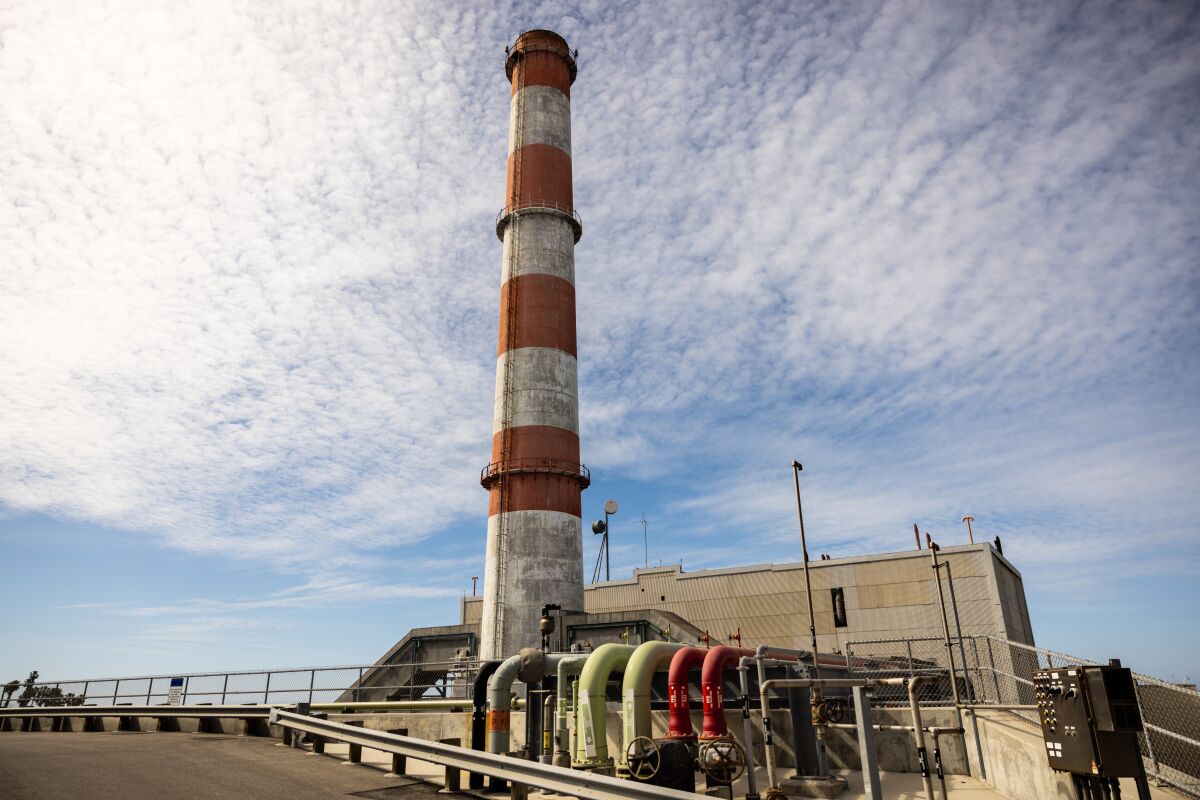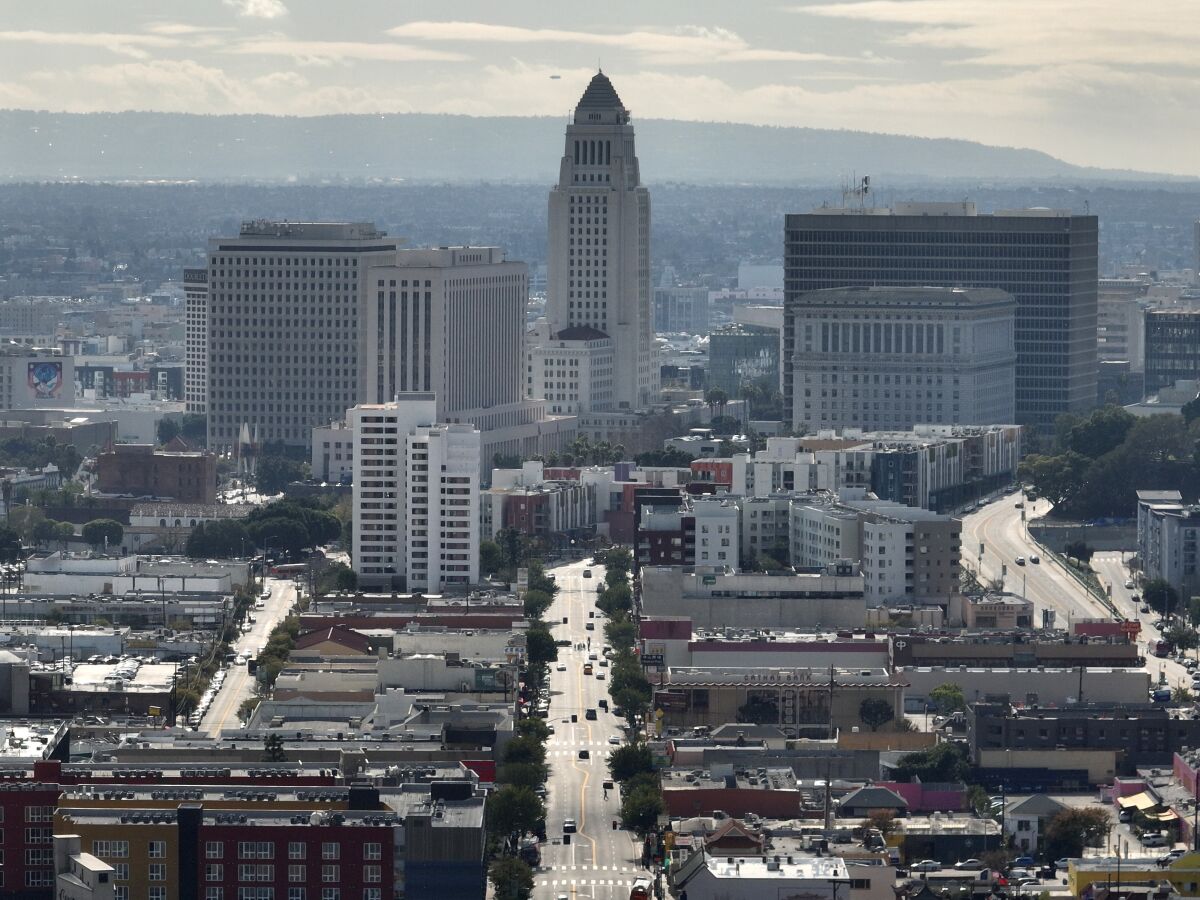The Los Angeles City Council voted unanimously Wednesday to move forward with an $800-million plan to convert the city’s largest gas-fired power plant to green hydrogen — a first-of-its-kind project that was hailed by supporters as an important step to solve the climate crisis but slammed by critics as a greenwashing boondoggle that will harm vulnerable communities.
Council President Paul Krekorian described hydrogen as crucial to meeting L.A.’s goal of 100% clean electricity by 2035.
“It was widely seen as being an impossible goal. And we’re now on the precipice of achieving that,” he said.
The vote authorized the L.A. Department of Water and Power to begin the contracting process for revamping Scattergood Generating Station, which sits along the coast near El Segundo.
DWP plans to install turbines capable of burning significant quantities of hydrogen, which has never been done before on such a large scale. The fuel would be produced from water, with renewable electricity — from solar panels or wind turbines, for instance — splitting H2O molecules into hydrogen and oxygen atoms.
The city-run utility hopes to ultimately convert its other gas plants to hydrogen as well: Harbor and Haynes farther down the coast, and Valley Generating Station in Sun Valley. Those facilities wouldn’t be fired up often, but they would help Los Angeles keep the lights on during times when there’s not enough solar and wind power to go around, such as hot summer nights.
The city’s ultimate goal is burning 100% green hydrogen — but DWP officials have acknowledged the technology might not be ready right away. That means the initial fuel mix at Scattergood might include more planet-warming natural gas than hydrogen.
Newsletter
Your guide to our clean energy future
Get our Boiling Point newsletter for the latest on the power sector, water wars and more — and what they mean for California.
You may occasionally receive promotional content from the Los Angeles Times.
Jason Rondou, DWP’s director of resource planning, told The Times that Scattergood should be able to burn at least 30% green hydrogen on Day One — the same percentage the utility is targeting at its coal-fired Intermountain Power Plant in Utah.
“There’s a lot of things that need to be figured out over the coming years,” Rondou said.
That uncertainty helps explain why many climate and environmental justice activists opposed Wednesday’s City Council motion.

A smokestack at Scattergood Generating Station near El Segundo.
(Jay L. Clendenin / Los Angeles Times)
In public comments before the vote, critics from groups including Communities for a Better Environment, Pacoima Beautiful and the Sierra Club noted that although hydrogen doesn’t produce planet-warming carbon emissions when burned, it does generate lung-damaging nitrogen oxide pollution — much more than gas, at least using current technology.
That’s especially problematic for low-income communities of color that have already suffered from years of fossil fuel pollution — like those around DWP’s Valley Generating Station, where residents were forced to live with a years-long methane leak.
Jasmin Vargas, an organizer with Food and Water Watch, described hydrogen as “fundamentally racist and inequitable.” She also objected to public comments from labor union and business leaders saying hydrogen would create good-paying jobs.
“The jobs that everybody’s talking about are not clean energy jobs,” she said.
Other activists pointed to the risk of explosions from hydrogen leaks and to research finding that hydrogen can worsen climate change in the short term if too much of it leaks from pipelines before it’s burned. They also raised the possibility that DWP’s experimental green hydrogen project could fail, leaving L.A. stuck burning natural gas when the city instead could have invested more heavily in battery storage, energy efficiency and other strategies to ditch fossil fuels while keeping the lights on.
“DWP should go back to the drawing board,” said Theo Caretto, a UCLA legal fellow at Communities for a Better Environment.
After hearing from opponents and supporters, the council voted 12 to 0 to move forward with the hydrogen plan — but only after approving a separate motion that newly elected Councilmembers Traci Park and Katy Young Yaroslavsky said would require DWP officials to more closely examine alternatives and more robustly engage with communities near the gas plant.
“Even with the additional oversight, safeguards and engagement, I am still very reluctant to vote to move this project forward,” Yaroslavsky said before the vote. “However, I am willing to support allowing the process to move to the next stage so that we can all collectively gather more information and understand its risks and its alternatives.”
It’s not yet clear, though, whether the City Council would be able to stop the Scattergood conversion if something went awry — costs spiraling out of control, for instance, or an inability by DWP to reduce nitrogen oxide pollution from burning hydrogen.
Further steps in the contracting process must be approved by the DWP board, whose members are appointed by the mayor. The City Council can override those decisions — but only with 10 supporting votes from the 15-member council, a high bar to clear.

A view of Los Angeles City Hall on Jan. 19.
(Myung J. Chun / Los Angeles Times)
In 2021, L.A. got one-quarter of its electricity from natural gas — a major contributor to the worsening fires, droughts and heat waves of the climate crisis. Gas usage on California’s power grid as a whole was even higher, at 38% — roughly the same as the country overall.
Green hydrogen has emerged in the U.S. and around the world as a potential substitute for natural gas on the electric grid — as well as gas piped to homes for heating and cooking. It’s one of many relatively high-cost technologies competing to complement low-cost solar panels, wind turbines and battery storage to zero out global climate pollution by midcentury.
Many climate activists do see a role for hydrogen — but mostly in “hard to electrify” industries where switching from dirty fuels to clean electricity is expected to be too expensive, such as shipping, aviation, steelmaking and potentially long-haul trucking. Those activists’ preferred technology is hydrogen fuel cells, which produce no pollution and can power heavy-duty trucks.
Activists are also cautious because the vast majority of hydrogen currently in use globally is produced from fossil fuels, adding to the climate crisis. The renewable “electrolysis” method for producing hydrogen planned by DWP is costlier and less efficient.
Adding to the skepticism over green hydrogen is that its loudest proponents are often fossil fuel companies.
In Los Angeles, that would be Southern California Gas Co., the nation’s largest gas utility. Last year, the company proposed Angeles Link, a massive and potentially lucrative pipeline that would bring green hydrogen fuel to the L.A. Basin.
“It allows California to dramatically advance its climate and environmental goals,” SoCalGas President Maryam Brown said at the time. “It creates a cornerstone for the California green hydrogen economy, and the hydrogen economy in general.”
“Southern California Gas is an infrastructure company. And we use that infrastructure to be able to meet customers’ needs,” she added. “Customers’ needs are changing. We see our customers needing cleaner and cleaner fuels.”
Support our journalism
Your support helps us deliver the news that matters most. Subscribe to the Los Angeles Times.
In an email ahead of the City Council’s vote Wednesday, SoCalGas spokesperson Chris Gilbride said company executives “have not been engaged, and are currently not engaged, on the Scattergood project.”
But there’s little question it could be a boon for SoCalGas, fueling demand for the company’s proposed pipeline and potentially leading to more widespread use of hydrogen.
Federal dollars could also accelerate L.A.’s hydrogen plans. The City Council voted last year to apply for a share of $8 billion in federal “hydrogen hub” funds, allocated by Congress as part of the bipartisan infrastructure bill signed by President Biden in 2021.
Whether or not that money materializes, DWP’s Rondou said Los Angeles has little choice but to bet on hydrogen.
“We certainly looked at all the different pathways to get to 100%” clean energy, he said, referring to an in-depth study conducted with the National Renewable Energy Laboratory. “But the study was clear. … There wasn’t an alternative.”
For all the latest Business News Click Here
For the latest news and updates, follow us on Google News.
